
Treating varroa mites organically
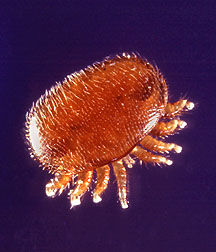 Ross Conrad spends 50 pages
talking about
the varroa mite, which he considers to be the current bane of the
organic beekeeper. Although I'm not interested in trying out his
"soft chemical" controls (which are on a toxicity level similar to Bt),
I'm intrigued by some of the other solutions he presents. Conrad
recommends using many or all of the options below in concert, and
warns that ignoring mites will kill your hive within one to two years
without some mite-reduction actions.
Ross Conrad spends 50 pages
talking about
the varroa mite, which he considers to be the current bane of the
organic beekeeper. Although I'm not interested in trying out his
"soft chemical" controls (which are on a toxicity level similar to Bt),
I'm intrigued by some of the other solutions he presents. Conrad
recommends using many or all of the options below in concert, and
warns that ignoring mites will kill your hive within one to two years
without some mite-reduction actions.
1.
Breed for resistant bees.
Natural beekeepers seem to be unanimous in their admonition to stop
buying out of town bees and to instead learn to breed bees that are
well-suited to
your local conditions. Bees resistant to varroa mites may be more
hygenic, brushing or biting mites off other bees' backs, and they may
also be more prone to swarm. Short of scientifically measuring
these traits, if you reproduce the genetics of the hives that
survive the winter in your apiary, you're automatically selecting for
bees that will do better in your area. (More on how to breed bees
in a later post.) Of course, this is a long term measure and
won't help your bees survive this year.
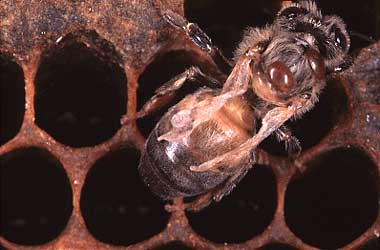 2. Monitor
for mites to know when to
take drastic action. Although Conrad
mentions several mite-counting
techniques, he takes
a simpler approach and keeps his eye out for
signs of high mite levels when he checks the hive. Noticing mites
on drone brood pulled apart during your hive
check, or wandering around in the hive, is a sign that mite populations
may be increasing and you need to keep an eye on the hive. If you
begin to see deformed wings on worker bees --- caused by a virus
carried by varroa mites --- then mite levels are too high and you must
take emergency measures.
2. Monitor
for mites to know when to
take drastic action. Although Conrad
mentions several mite-counting
techniques, he takes
a simpler approach and keeps his eye out for
signs of high mite levels when he checks the hive. Noticing mites
on drone brood pulled apart during your hive
check, or wandering around in the hive, is a sign that mite populations
may be increasing and you need to keep an eye on the hive. If you
begin to see deformed wings on worker bees --- caused by a virus
carried by varroa mites --- then mite levels are too high and you must
take emergency measures.
3.
Split off nucleus colonies.
The simple action of propagating your hive seems to put a damper on
mite reproduction since splitting causes a pause in brood production
within the
hive. Varroa mites reproduce by laying eggs on bee brood, so if
the bees aren't producing brood, the mites can die out.
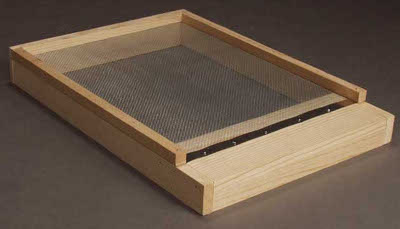 4. Use screened bottom boards.
By using a screened bottom board instead of a solid bottom board, when
mites fall off a bee's back, they tend to fall through the holes onto
the ground and die rather than jumping aboard the next bee who passes
by. Screened bottom boards reduce your mite levels by 10 to 20%,
and Conrad notes that even in his northern location, leaving screened
bottom boards open all winter doesn't cause increased winterkill.
4. Use screened bottom boards.
By using a screened bottom board instead of a solid bottom board, when
mites fall off a bee's back, they tend to fall through the holes onto
the ground and die rather than jumping aboard the next bee who passes
by. Screened bottom boards reduce your mite levels by 10 to 20%,
and Conrad notes that even in his northern location, leaving screened
bottom boards open all winter doesn't cause increased winterkill.
5.
Encourage mites to fall.
Various techniques can be used in conjunction with screened bottom
boards to cause even more mite casualties by tricking mites into
loosening their hold on a bee. Plugging up all the holes in a
hive and then filling the hive with the smoke of tobacco, black walnut,
cedar, grapefruit leaves, or creosote bush for 30 to 60 seconds before
airing the hive out causes major mite falls (although tobacco and
creosote smoke may also harm the bees.) Alternatively, you can
sprinkle confectioner's sugar over your bees, which tempts the bees to
groom mites off (but don't use confectioner's sugar during cold weather
since it contains an inert ingredient that your bees will need to void
from their systems.) Both of these techniques should be used when
no honey is present in the hive to prevent contamination, and most
should be repeated two or three times over the course of a few weeks to
catch mites on bees who were out foraging or were in capped brood cells
during the first treatment.
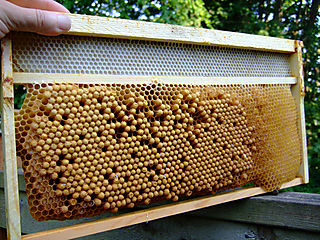 6. Trap mites. Since
varroa mites like drone brood much better than worker brood, you can
kill a lot of mites by putting a sheet of drone foundation in your
hive, waiting for it to be drawn out and filled with capped brood, then
freezing the frame for 26 to 30 hours to kill drones and mites.
You should repeat this technique throughout the year, moving the drone
frame throughout the hive, but it does seem a little hard on all of
those dead drones (who you need if you're going to breed your own new
queens.) Alternatively, Conrad builds mite traps that look like a
deep frame, but with boards on each side covered in slits too small for
a bee to fit through. In the bottom of this little box, he puts a
piece of sticky paper covered with methyl palmitate bait to attract and
then catch the
mites. The sticky paper needs to be changed once in the middle of
summer and the whole trap is removed in August.
6. Trap mites. Since
varroa mites like drone brood much better than worker brood, you can
kill a lot of mites by putting a sheet of drone foundation in your
hive, waiting for it to be drawn out and filled with capped brood, then
freezing the frame for 26 to 30 hours to kill drones and mites.
You should repeat this technique throughout the year, moving the drone
frame throughout the hive, but it does seem a little hard on all of
those dead drones (who you need if you're going to breed your own new
queens.) Alternatively, Conrad builds mite traps that look like a
deep frame, but with boards on each side covered in slits too small for
a bee to fit through. In the bottom of this little box, he puts a
piece of sticky paper covered with methyl palmitate bait to attract and
then catch the
mites. The sticky paper needs to be changed once in the middle of
summer and the whole trap is removed in August.
7.
Use heat to kill the mites.
A temperature of 116.6 degrees Fahrenheit will kill varroa mites, but
not bees, so some beekeepers build special heating chambers into which
they pour their bees once a year to delete the mites. This sounds
pretty tricky, but Conrad also mentions that painting your hive boxes
a dark color might do the job for you --- at temperatures above 97,
brood within the hive will die, but it might be worth it to let the
hive get too hot a few times a year to keep mite levels manageable.
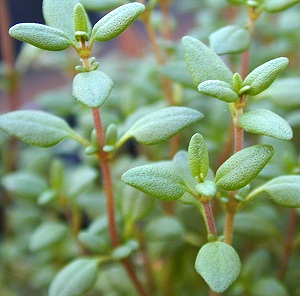 8. Use essential oils of thyme and
mint. A
variety of chemical companies have started making
"organic" mite controls out of thymol and L-menthol dissolved in a
grease patty, but Conrad admits that these chemicals cause a temporary
lull in egg-laying by the queen, which doesn't sound very healthy for
the hive. I wonder if you could plant a bed of thyme and mint
around your hive and get mites to drop off workers as they pass over
the anti-mite planting?
8. Use essential oils of thyme and
mint. A
variety of chemical companies have started making
"organic" mite controls out of thymol and L-menthol dissolved in a
grease patty, but Conrad admits that these chemicals cause a temporary
lull in egg-laying by the queen, which doesn't sound very healthy for
the hive. I wonder if you could plant a bed of thyme and mint
around your hive and get mites to drop off workers as they pass over
the anti-mite planting?
9.
Make your foundation cells smaller.
I've discussed the benefits of foundationless frames
previously. Suffice it to say that if you get your bees to build
cells a more natural size, mites don't fit in as well and mite
populations plummet.
We're already using
options 2 and 4 (and 7 accidentally when we had our
hive meltdown
last summer), and this year I plan to split our hives to
start working on options 1 and 3. I'm curious to see whether
throwing a few black walnut leaves in the smoker when I check on the
hive in the summer might act as a milder version of option 5, and I
hope to remember to plant mint around the hives this year. What
organic techniques do you use to keep your hives' varroa mite levels
within bounds?
| This post is part of our Natural Beekeeping lunchtime series.
Read all of the entries: |
Want more in-depth information? Browse through our books.
Or explore more posts by date or by subject.
About us: Anna Hess and Mark Hamilton spent over a decade living self-sufficiently in the mountains of Virginia before moving north to start over from scratch in the foothills of Ohio. They've experimented with permaculture, no-till gardening, trailersteading, home-based microbusinesses and much more, writing about their adventures in both blogs and books.
Want to be notified when new comments are posted on this page? Click on the RSS button after you add a comment to subscribe to the comment feed, or simply check the box beside "email replies to me" while writing your comment.

Hi,
I think this may be something you may want to consider in your efforts to control varroa mites.
Paul Stamets - Six Ways Mushrooms can Save the World http://www.ted.com/talks/paul_stamets_on_6_ways_mushrooms_can_save_the_world.html
Field Trials Using the Fungal Pathogen, Metarhizium Anisopliae http://www.ars.usda.gov/research/publications/publications.htm?SEQ_NO_115=140685
My grandfather planted Thyme and Peppermint in his bee yard for as long as I remember. I do the same thing. The only treatment I use. I check my screened bottom boards a couple of times a season and see no reason to change.
not sure what part of black walnut is intended to be burned for smoke by the original source, you suggest maybe its leaves in the smoker...
maybe the leaves have it too, not sure as I said, but I do know Black Walnut wood which is black (surprise) and smells very creosotey, like a railroad tie but in a good natural way (if that can be imagined).
Black Walnut is awesome kindling as this pitchiness burns like mad and it splits easily to as small a pieces as you like.
I HAVEN'T TRIED THIS YET, but I'd think making splinters and adding it to a smoker would work well for this anti-mite smoking as suggested
http://mysare.sare.org/wp-content/uploads/8792865.pdf
all the trials I can find use leaves, the above trial suggest a rather dreamy optimism regarding honey production...
just wanted to update and suggest caution, if I ever have a major mite problem in my hives I'm going to try the WOOD smoke as I suggested as the smell of it burning in my stove just demands such a test...
I'll let you know, but hopefully not for a long time